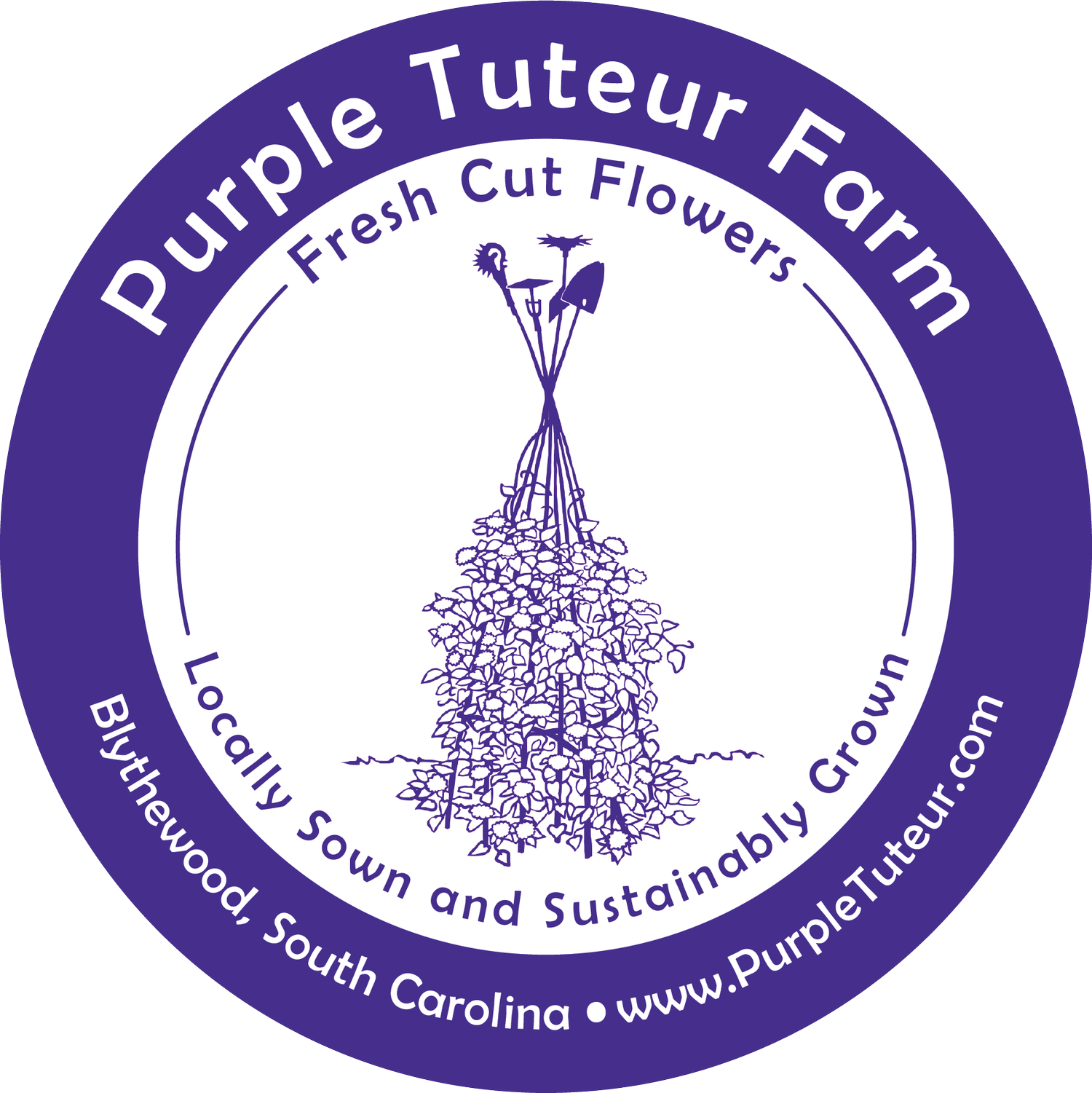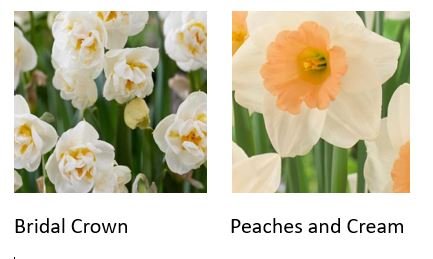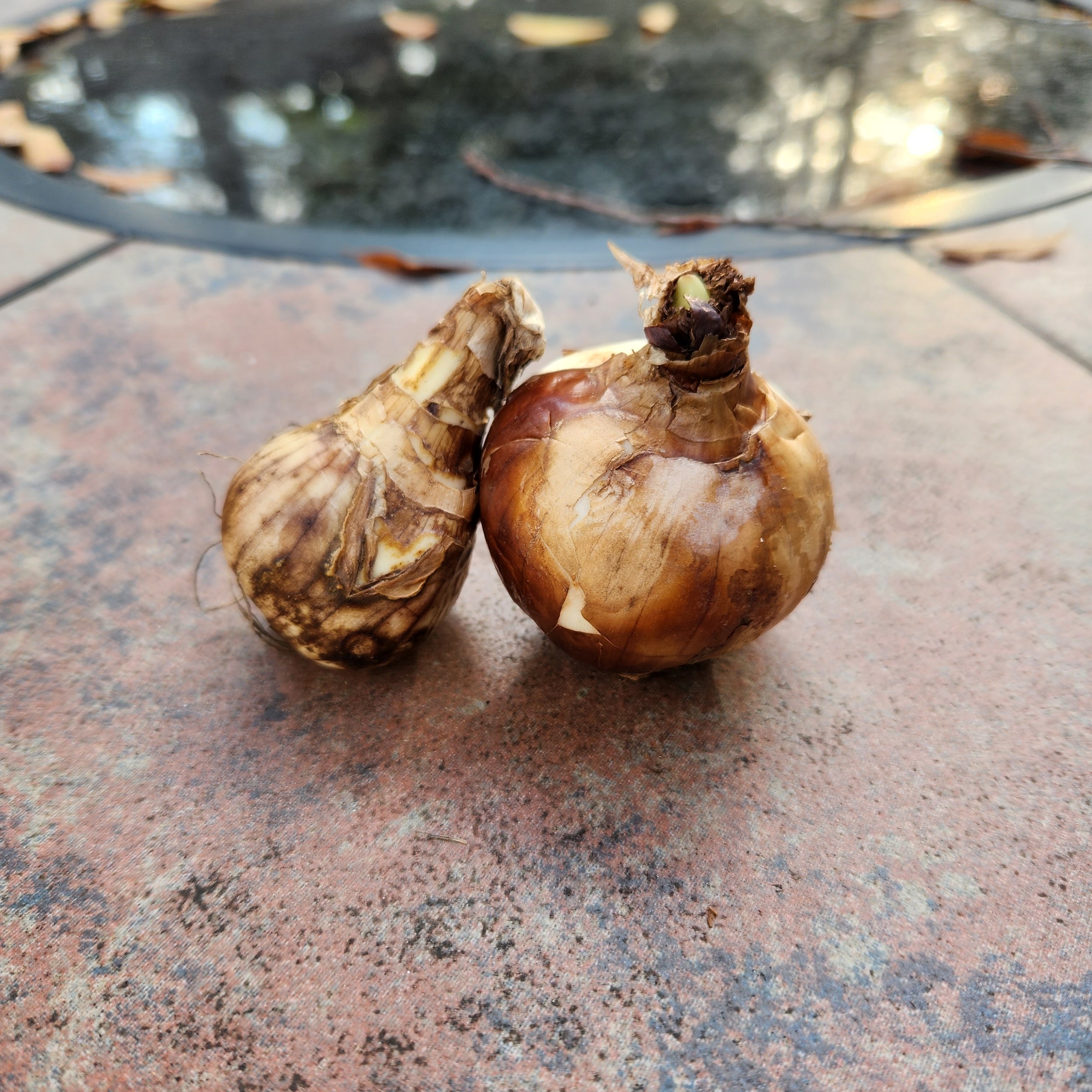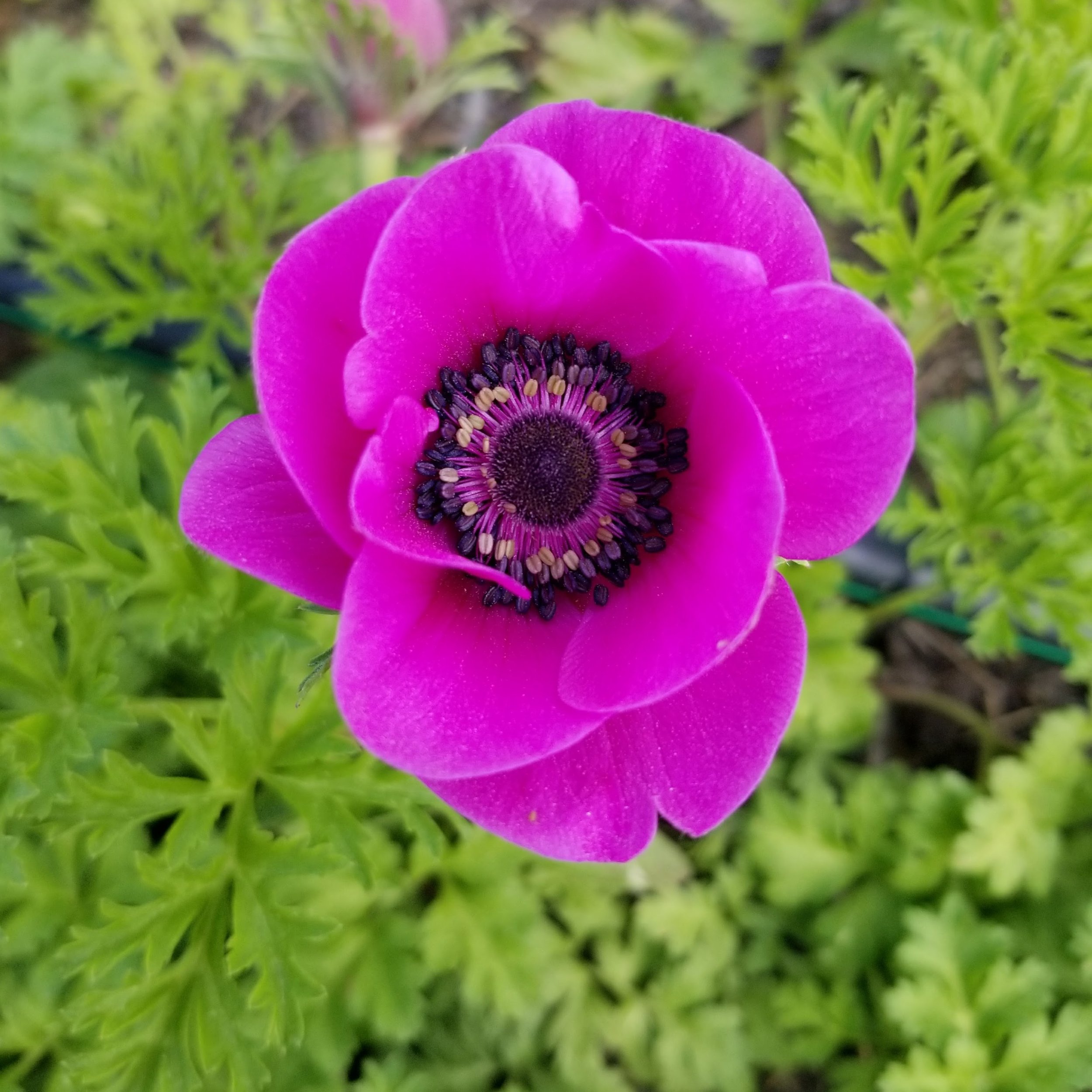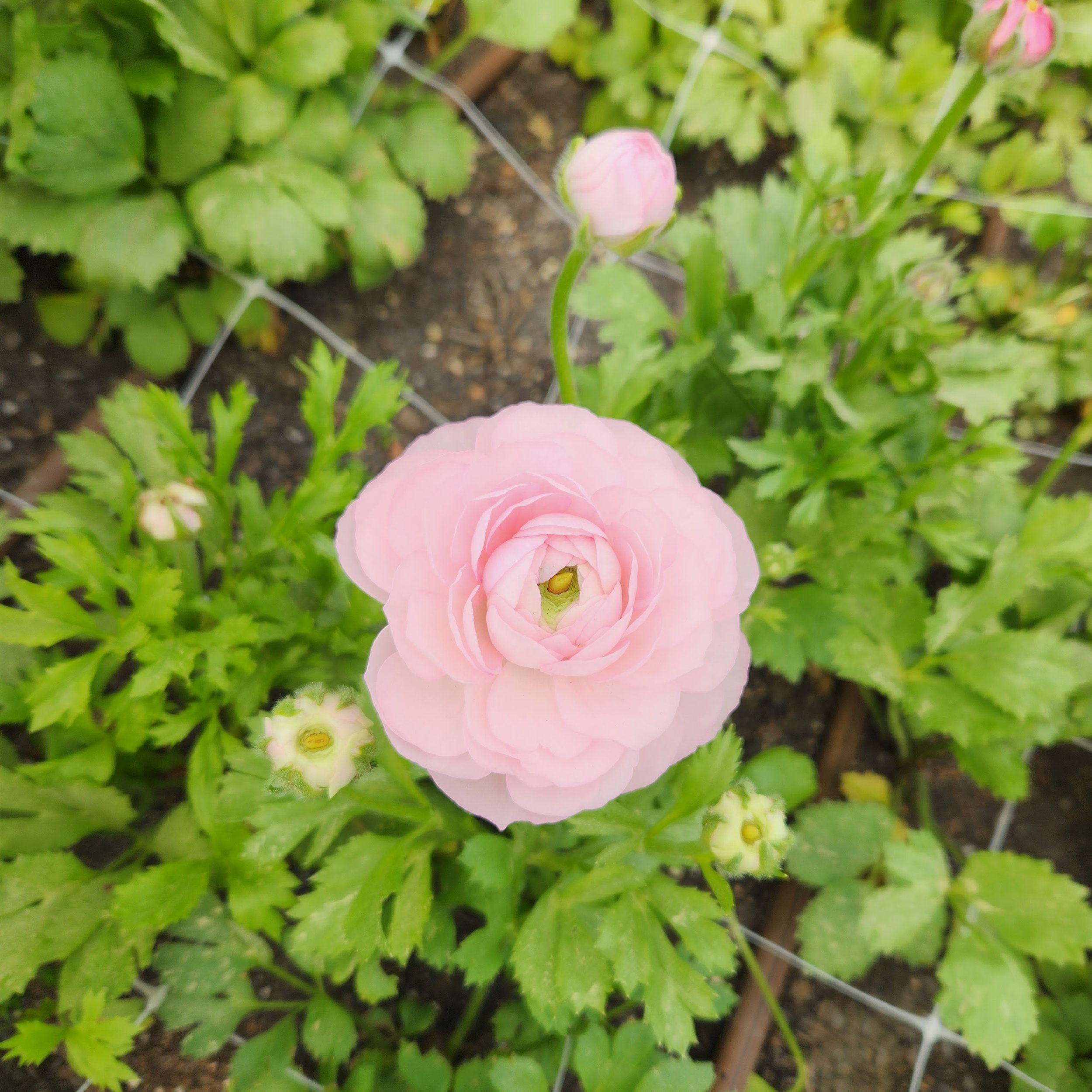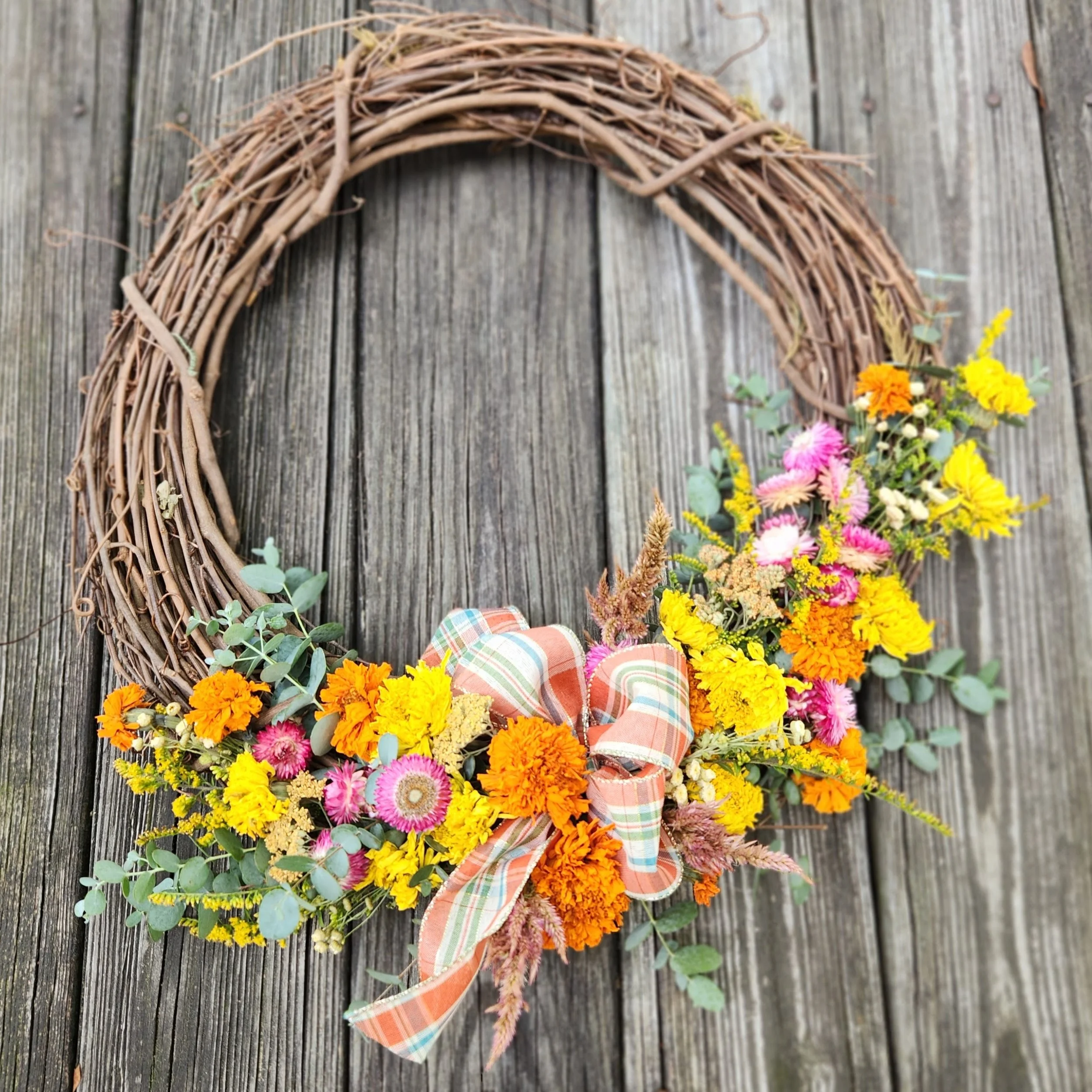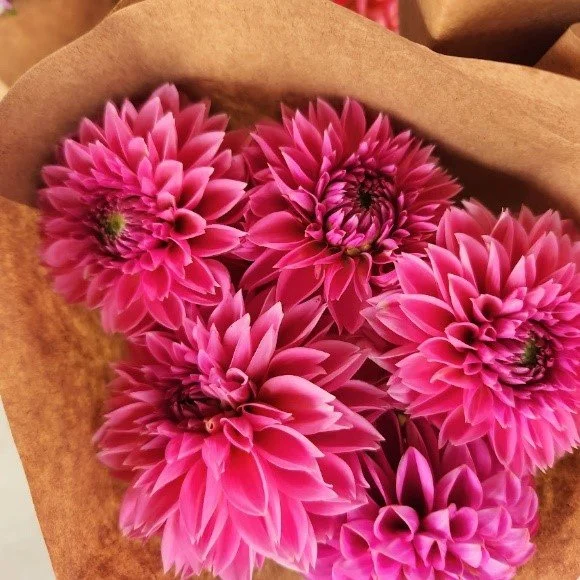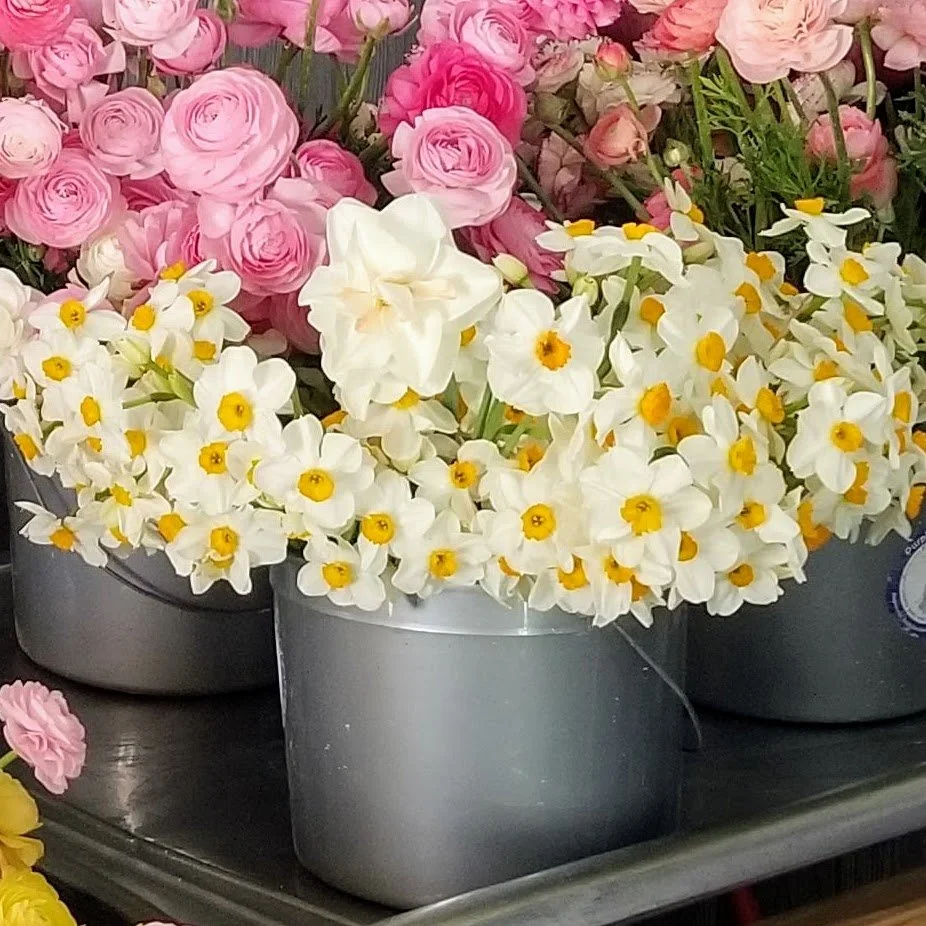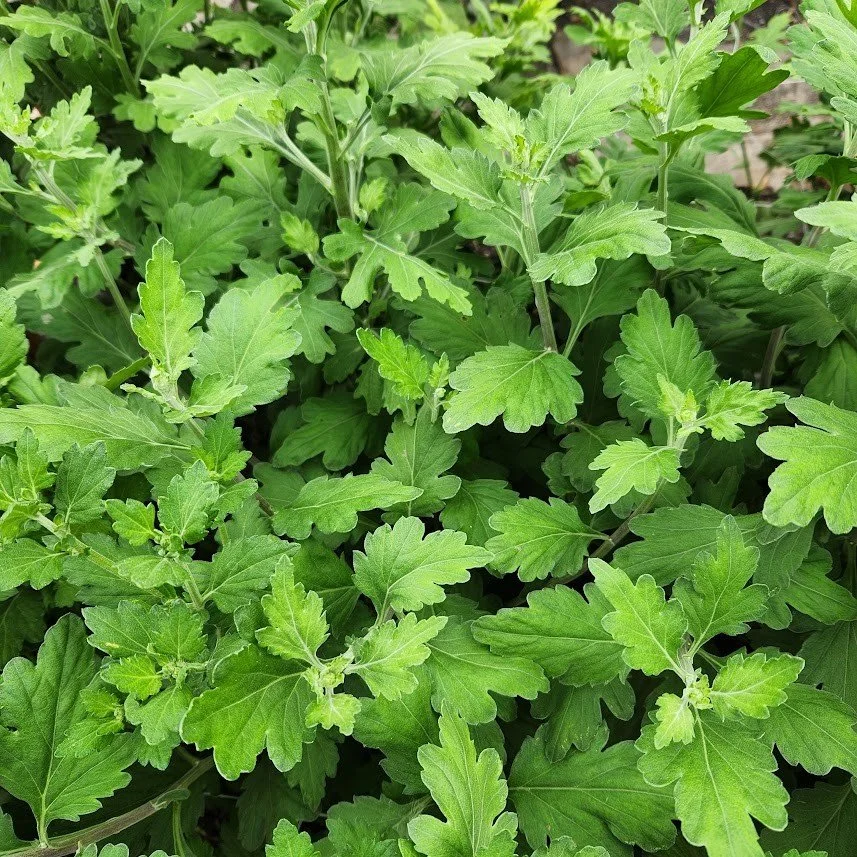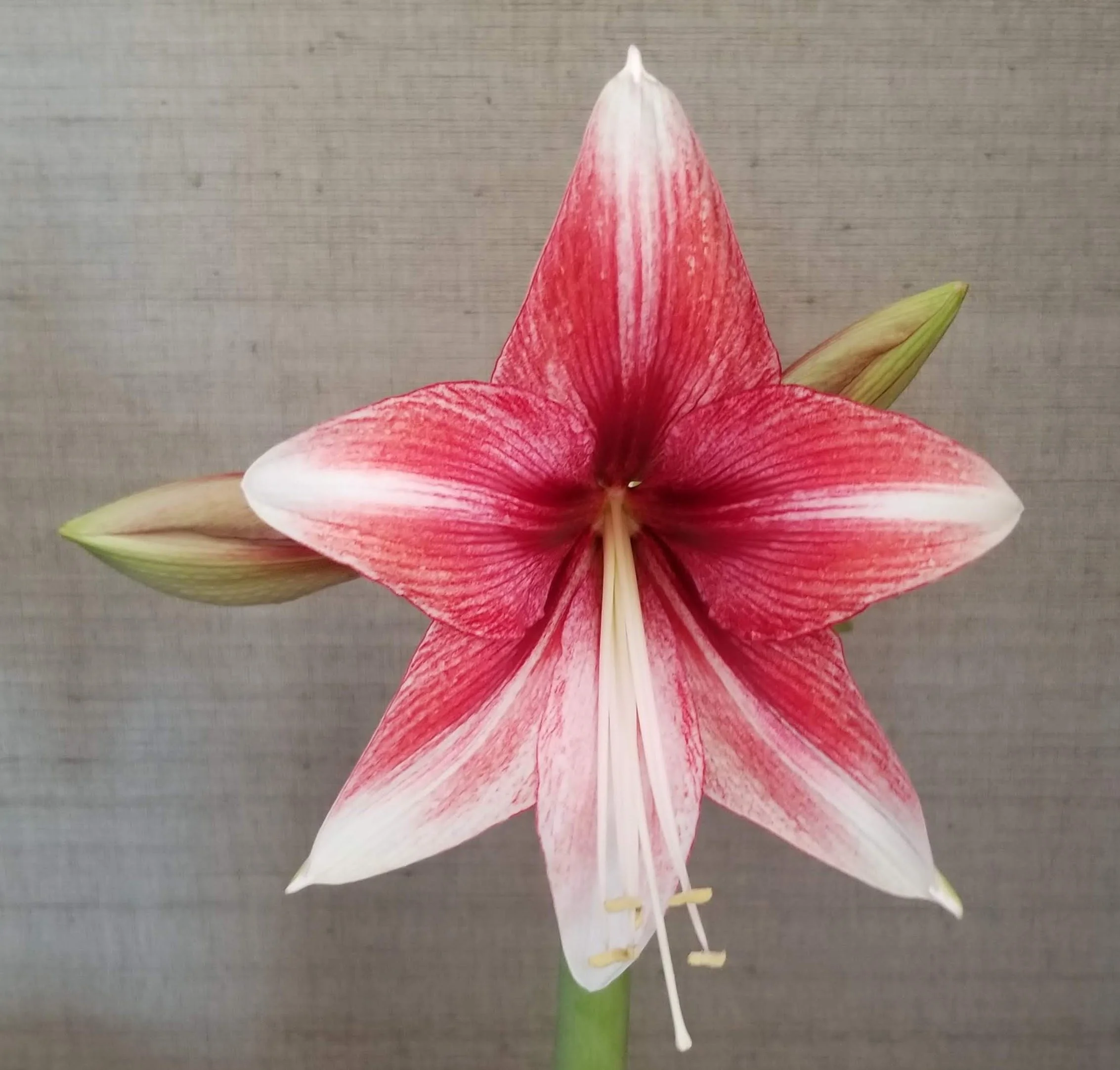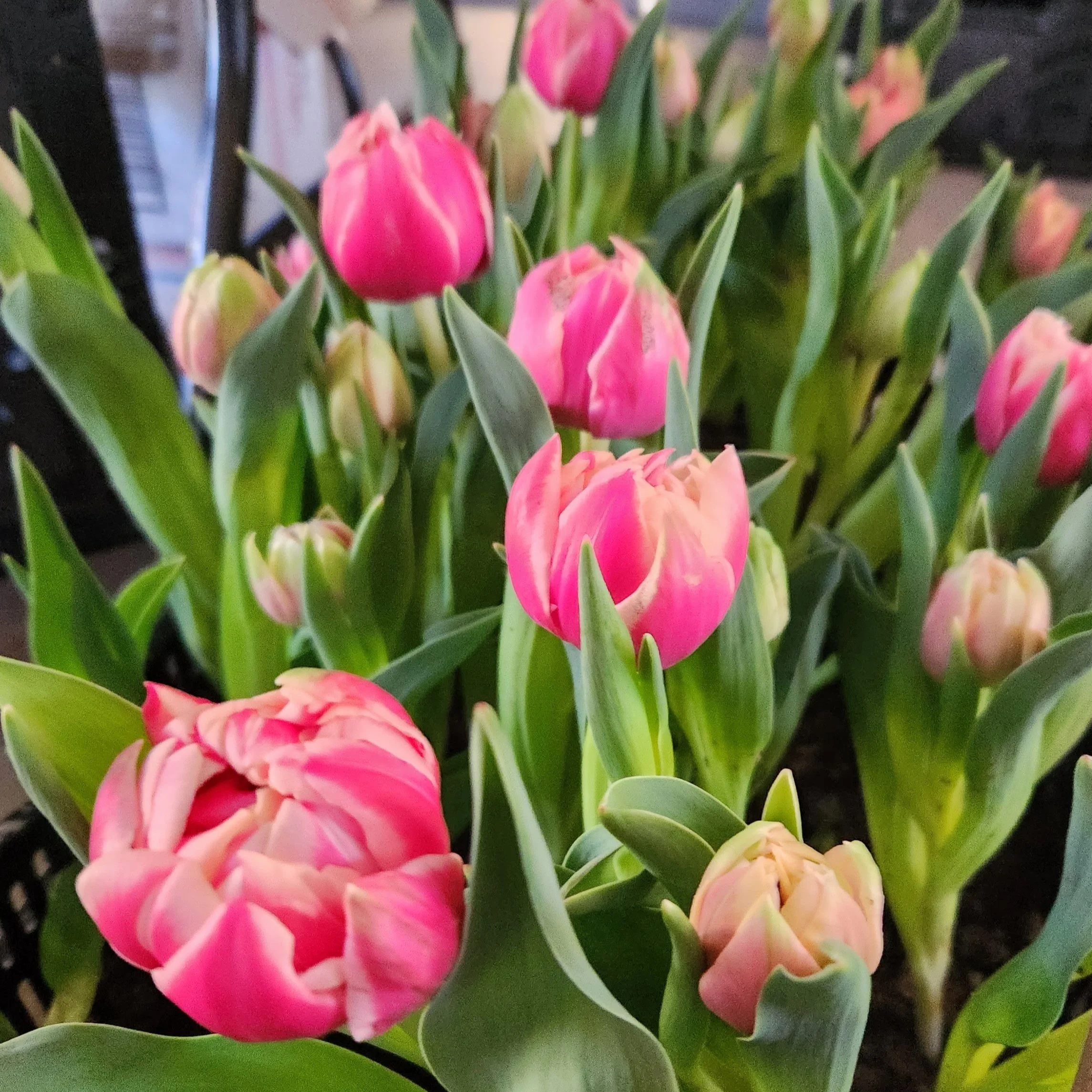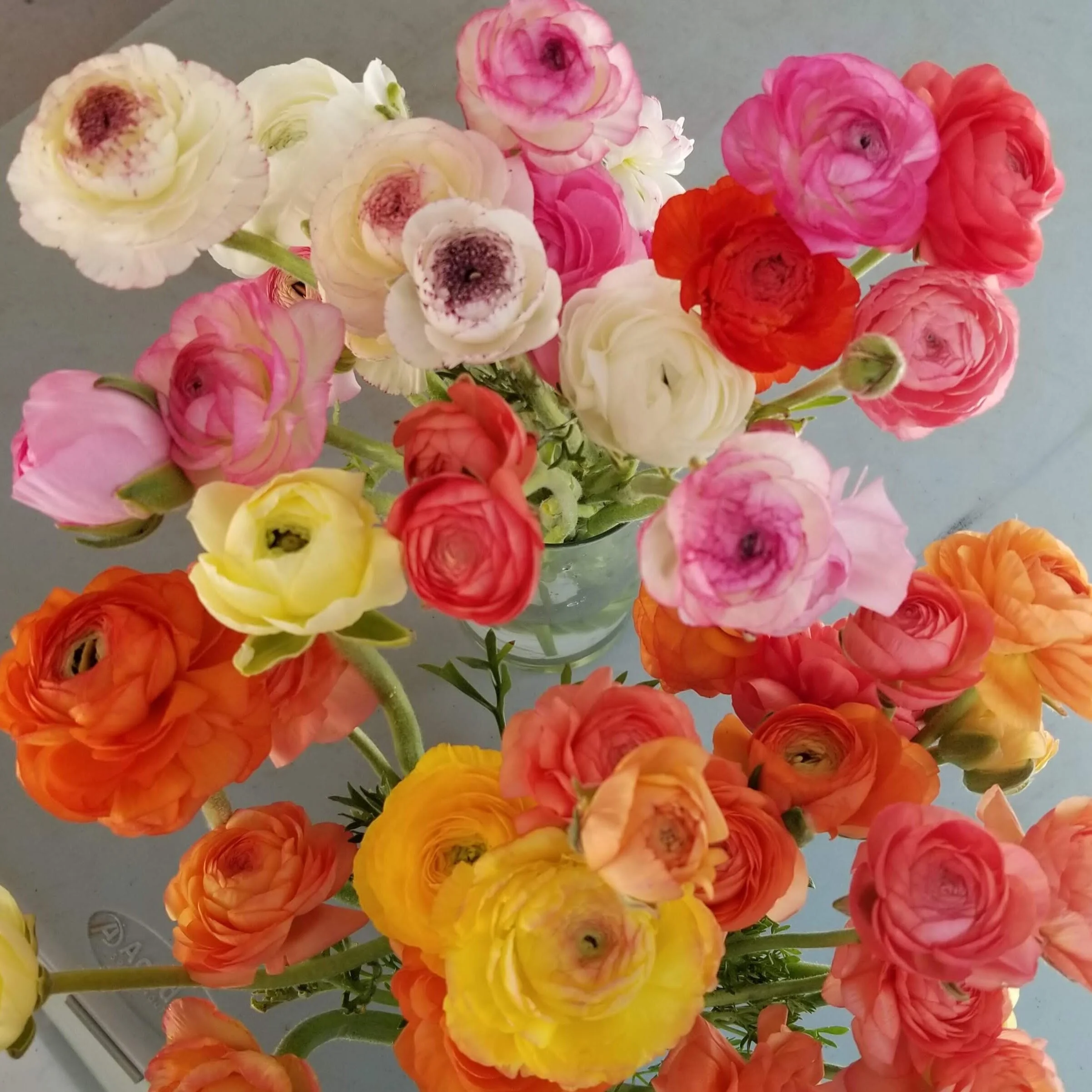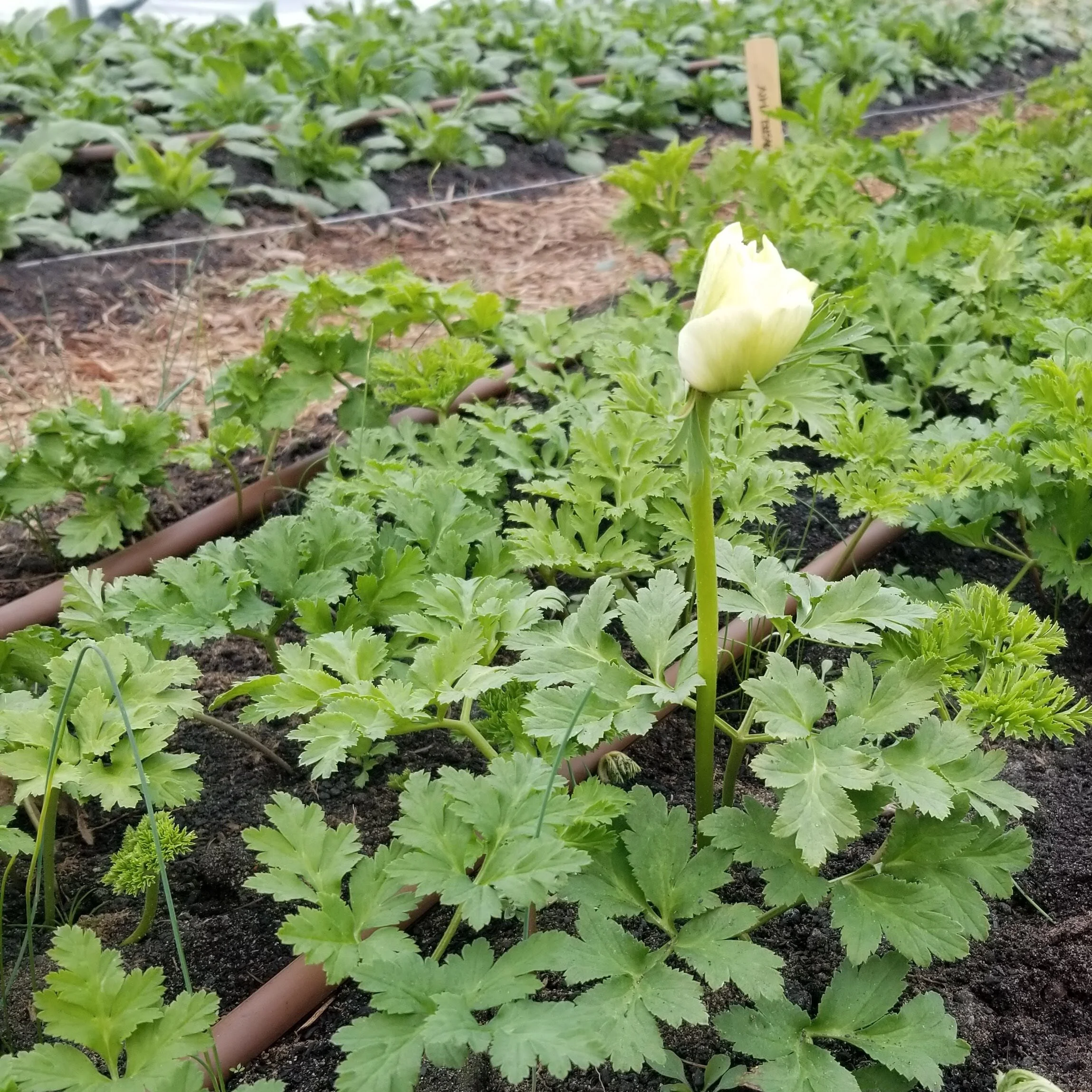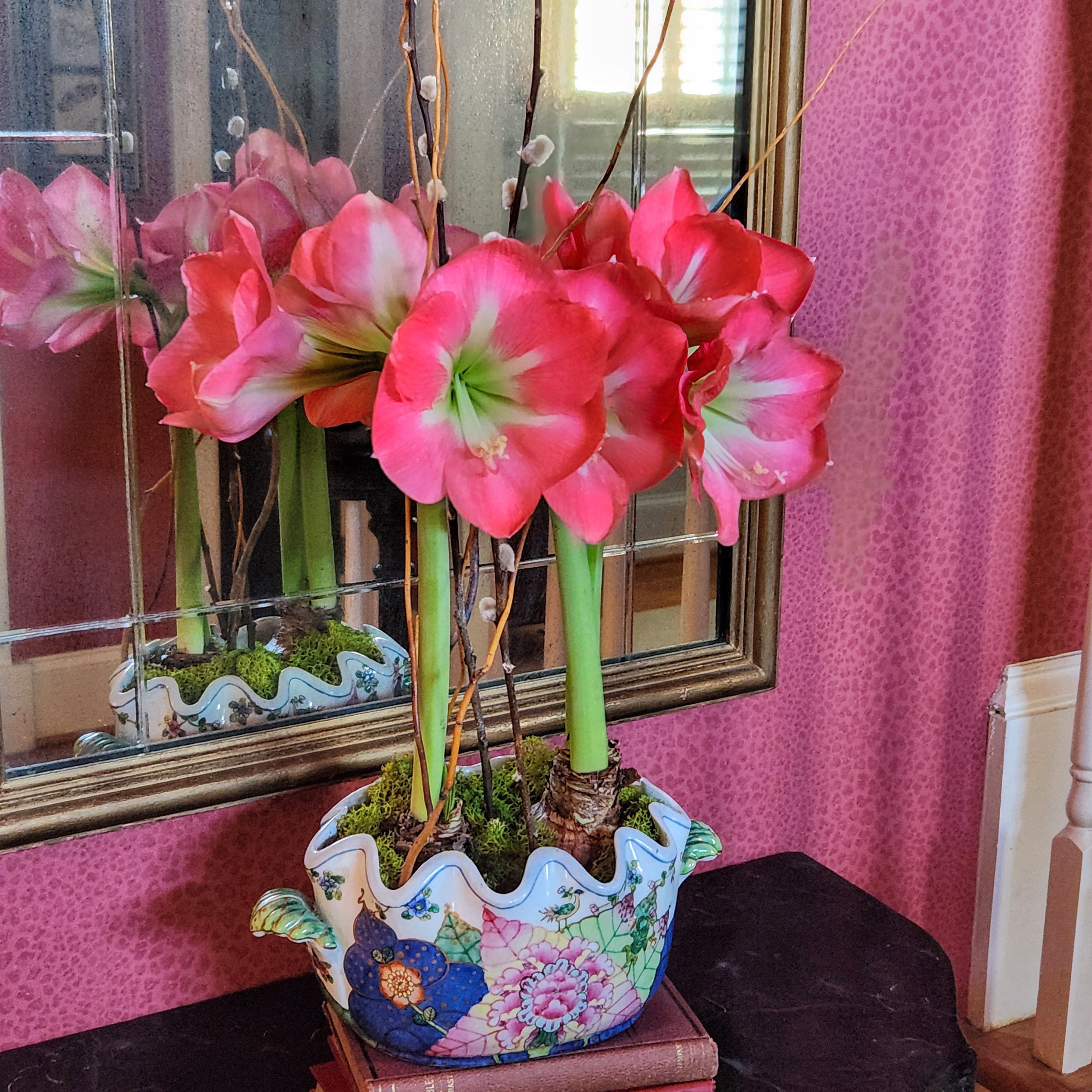
Amaryllis Care
Amaryllis Care Guide: How to Grow for Blooms Indoors and Outdoors
Amaryllis are treasured for their ability to produce large, vibrant flowers indoors during the coldest months of winter. Their low-maintenance care and potential for reblooming make them a favorite among indoor gardeners. Follow this guide to enjoy the beauty of amaryllis year after year indoors, or to transition them outdoors to enjoy in your garden here in Columbia.
Amaryllis Cape Horn
Choosing Your Amaryllis Bulbs
Look for firm, unblemished bulbs, similar to how you would choose an onion. Larger bulbs produce more stems and flowers. For a more impressive display, choose the largest bulbs you can find. The flowers are already formed in the bulb when you receive them, so larger bulbs will have more and larger flowers.
While red and white varieties are the most common, amaryllis is also available in shades of pink, burgundy, orange, yellow, and even green.
Select bulbs from the southern hemisphere (sometimes referred to as “Christmas Blooming”) if you want them to bloom for the holidays, or as fast as possible (4-6 weeks). Bulbs from the northern hemisphere (sometimes called “shelf stable”) will bloom after the holidays, since they are going to take longer to acclimate to the warmth of your home. Typically, these take 6-10 weeks to bloom and are wonderful to have in bloom in January and February,
How to Grow Amaryllis Indoors
Preparing Your Amaryllis Bulb
Wake the Bulb: Soak the roots in warm water for about an hour, then allow them to drain completely.
Planting: Use well-draining potting soil and pot the bulb, leaving about one-third of the bulb above the soil surface.
Initial Watering: Thoroughly soak the soil with warm water after planting, then refrain from watering until green shoots appear.
Placement: Keep the pot in a warm, dark spot (70-75°F) for two weeks to encourage root development.
Pro Tip: If your bulb has already started sprouting, don’t worry. The stem will naturally straighten as it grows.
Encouraging Blooms
Move to Light: Once roots are established, place the pot in a bright, warm location (70-80°F). A sunny windowsill or a spot near a heat source works well.
Watering: Water only when the top inch of soil feels dry. Avoid overwatering, as this can lead to bulb rot.
Patience is Key: Growth may take several weeks. Keep the pot warm and avoid excessive watering.
Rotate for Even Growth: When the stem begins to emerge, rotate the pot daily to ensure the stalk grows straight.
Caring During the Bloom period
Prolong Blooms: Once the flowers open, move the pot out of direct sunlight to extend bloom time.
Deadhead Regularly: Remove fading flowers by cutting them near the base of the stalk. This can encourage additional blooms.
Trim Spent Stalks: After all flowers have faded, cut the stem back to about 2 inches above the bulb. Leave green leaves intact to nourish the bulb for next season.
How to Save Amaryllis Bulbs for Reblooming Indoors
Post-Bloom Care: Place the pot in a bright location and continue watering when the top inch of soil feels dry. Fertilize monthly.
Summer Outdoors: Two weeks after the last frost (mid-April in Columbia), move the pot outside to a sunny or partially shaded area to promote leaf growth and strengthen the bulb.
Fall Dormancy Preparation:
In early fall, cut the foliage just above the bulb.
Bring the pot indoors and place it in a cool, dark location (50-60°F) for 8-10 weeks.
Do not water during the dormancy period.
Restart Growth: After the dormancy period, follow the initial growth steps to encourage blooming once again.
Note: Amaryllis bulbs thrive when slightly pot-bound. Repotting every year is not necessary, allowing for easy long-term care.
By following these steps, you can enjoy beautiful amaryllis blooms during the winter months and cultivate healthy bulbs that rebloom season after season.
Growing Amaryllis Outdoors
Amaryllis also makes an excellent garden plant and is cold hardy in South Carolina through USDA planting Zone 8. This means Amaryllis grown indoors during the holiday season can be moved outdoors in the spring after the threat of frost has passed, generally around mid-April. Gradually acclimate the indoor plants to brighter light by moving them to a porch or patio area before planting them in the garden.
find the right location
Amaryllis, like all bulbs, need soil that drains well. A raised bed may be necessary to ensure good drainage if your soil has a lot of clay in it. A soil rich in organic matter will provide the best growth, so add compost if your soil is lean like ours. Plant bulbs directly into the ground, spaced about a foot apart. Plant with half the bulb tip above ground, leaving the tops barely covered with soil.
Select a sunny spot in the garden that receives afternoon shade. Avoid placing the bulb where it will dry out excessively. Apply mulch, especially during the fall and winter months. Leaves work well for this.
Fertilize
Fertilization determines the size and quality of the flowers and foliage. For garden plantings, fertilizers containing low nitrogen, such as 5-10-10 or 6-12-12 analysis should be used. Use quantities as defined on the fertilizer bag. Make the first fertilizer application as new growth begins, then repeat the application when the flower stalk is 6 to 8 inches tall, before blooming. Do not feed while the plant is in bloom. Apply a third application immediately after flowering. Remove spend stalks/blooms but keep the leaves on the plant.
Amaryllis grown outdoors are deer resistant. They will grow lush foliage outdoors over the summer, storing energy for future blooms.
A Versatile Bloom for Every Season
Whether you’re decorating your home for winter, planning thoughtful gifts, or adding beauty to your garden, amaryllis is a wonderful choice. With its vibrant colors and easy care, it’s a simple way to brighten any space.
We carry amaryllis bulbs each year starting in early November. You can find our selections at this link : https://www.purpletuteur.com/garden-bulbs
Important Updates for the Holiday Season
The Bulb Shop Is Open!
We’re thrilled to announce that our bulb shop is officially open at www.purpletuteur.com! Browse our curated selection of beautiful amaryllis, paperwhites, daffodils, tulips, and peonies, all chosen to bring vibrant color and fragrance to your home and garden this season. Whether you’re looking for holiday blooms or planning ahead for spring, we have something special for everyone. PLEASE NOTE: Local delivery and pick up only for these items. Deliveries are made on Tuesdays and Fridays. Deliveries will begin on 11/15, assuming everything in your order has arrived by then. (Everything is due in the week of 11/11). Farm pick up is available on the following dates from 10:30-12:30. November 20,23,27 and December 4,7,14. If these dates don’t work, please contact us and we will try to accommodate you.
For both pick up and delivery, we will notify you when your order is ready.
Come See Us at the Blythewood Farmers Market Holiday Market!
On another note, we unfortunately have to cancel our Holiday Open House due to a recent water pipe burst in the farmhouse. With repairs underway and water being turned off periodically, it’s best to hold off on hosting events at the farm for now. However, we will still offer pick-up for online orders—just plan accordingly around the bathroom limitations!
We’re excited to announce that we’ll be at the Blythewood Farmers Market Holiday Artisan Market on November 23rd from 10:00 am - 3:00 pm. instead. Come by and see us there to pick up some of your holiday favorites!
Visit www.purpletuteur.com now to explore our full collection and place your orders before they sell out.
2025 Subscriptions
Our 2025 Subscriptions will be available for purchase starting 11/11/2024. Get your holiday gift shopping done or give yourself the gift of wellness with fresh flowers. Watch for our email update!
Thank you for all your support of our small farm. We are grateful and honored to serve you.
Best,
Linda
Winter Bulb Season is Here!
Hello Flower Friends,
I’m excited to bring you some wonderful news – our fall bulbs have arrived in the U.S., and many are already at the farm! While we’re updating the website and preparing for orders to go live by Wednesday, here’s a quick preview of what’s available and how to make the most of these beautiful blooms in the South.
Amaryllis
Amaryllis bulbs are a wintertime favorite, known for their stunning, trumpet-shaped blooms and bold colors that brighten up indoor spaces during the colder months. Our selection includes vibrant reds, delicate pinks, pure whites, and other striking hues. These low-maintenance bulbs are easy to grow indoors, bringing life and beauty to any room with minimal effort.
Early/ Holiday Bloomers
Amaryllis typically bloom 6-8 weeks after planting, making them a perfect choice for holiday décor or as a thoughtful gift. With blooms that can reach up to 10 inches across, each flower makes a big impact. Amaryllis are also long-lasting, with individual blooms lasting several weeks and bulbs often producing multiple flower stalks. For an extended display, stagger planting times to enjoy these gorgeous flowers all winter long.
Paperwhites
We’re pleased to offer Paperwhite NIR, an especially fragrant variety perfect for brightening up indoor spaces. With elegant, pure white blooms, Paperwhite NIR grows quickly and requires no chilling period. As easy-to-grow indoor bulbs, they only need 3-4 weeks to bloom, filling your home with their signature sweet fragrance. Perfect for holiday decorating or as a thoughtful gift, these bulbs are a favorite for their simplicity and beauty.
Daffodils
We’re delighted to offer daffodils again with two varieties that flourish in Southern gardens:
Bridal Crown – Known for its soft, creamy-white petals and yellow centers, Bridal Crown has a lovely, multi-layered bloom structure and a captivating fragrance. It’s a great choice for Southern gardeners looking for both beauty and scent.
Peaches and Cream – With ivory white petals and delicate pale peach cups, Peaches and Cream is an enticing large-cupped daffodil. Its soft color palette blends effortlessly into any garden, making it ideal for spring displays. These easy-to-grow daffodils are excellent for naturalizing and make perfect cut flowers.
Tulips
Growing tulips in the South requires a bit of extra care, as our winters aren’t cold enough for the bulbs to thrive naturally. Our tulips have been pre-chilled to ensure they bloom beautifully in spring. Here are this season’s stunning options:
Mango Charm – This warm-toned tulip has rich, sunset hues of orange with hints of pink, creating a tropical focal point in garden beds or pots. It’s perfect for adding a lively pop of color to cut arrangements.
Negrita – A deep, velvety purple tulip, Negrita pairs beautifully with Mango Charm. Its moody, dramatic hue adds elegance and depth to any display, offering a modern, high-impact spring look.
Tip: Growing tulips in pots can give them an extra chill since above-ground temps are cooler than soil temperatures.
Peonies
We’re delighted to offer an early-season herbaceous peony that thrive in warmer climates. Sunny Girl is a standout with its rare pastel yellow blooms, perfect for adding a cheerful touch to the garden and as a beautiful cut flower. Its large, eye-catching flowers are sure to be a favorite!
For more detailed growing tips on peonies in warmer climates, check out our blog post here.
Stay tuned as we prepare the website for orders, and feel free to reach out with any questions. Happy planting, and here’s to a gorgeous season of blooms! 🌷
Our Fall Bulb Sale Starts Today!
We are excited to bring you our selection of spring blooming Anemone and Ranunculus bulbs!
These are the same bulbs that we grow at the farm, so you can be assured that they are appropriate for our climate. Growing instructions are included with your order.
We can ship your bulb order anywhere in the United States. We will start shipping orders in mid-October.
Here is the link to our website. Happy shopping!
ANEMONE
These are longer stemmed varieties and make excellent cut flowers. They have stems of 10 - 12 inches vs. the landscape de Caan varieties with 6 inch stems that are widely available.
There are two blue varieties that are not yet posted for the sale. I am waiting for them to arrive before I add them to the store.
Growing instructions are included with your purchase. You can also check out our blog post on growing ranunculus and anemone here.
RANUNCULUS
These are longer stemmed varieties and make excellent cut flowers. They grow well in pots or in the ground. Growing instructions are included with your purchase. You can also check out our blog post on growing ranunculus and anemone here.
NARCISSUS / DAFFODILS
We are not planning to offer daffodils this year. We are looking for a new supplier.
PEONIES/AMARYLLIS/PAPERWHITES/TULIPS
The peonies, amaryllis and paperwhites are not available for this sale. We hope to have them later in the year. There has been serious flooding in Holland both this past summer and the summer before causing damage to some of these crops. This, combined with the longshoremen’s strike, will create shortages. Will we have all of these? We sure hope so!
Bulb Forcing Class Update
Hi All,
Spring is another week closer! Flowers are beginning to show up on the farm, and the weather this week looks fabulous. We’re excited to get the season off the ground.
Class Update
The class on Forcing Bulbs for Winter Blooms has been rescheduled to Saturday March 9th from 10 am until noon. I appreciate everyone’s patience with the date change since I got sick and things had to move. In this class, we do a deep dive into how to prepare your bulbs for early bloom, covering those that have to be chilled and amaryllis and paperwhites, which do not. Then you will have access to prepared bulbs that we have been cooling since November to make your own bulb garden to take home. Grab a friend and join us! We’d love to have you. Light refreshments will be served.
For the details and to sign up, follow this link:
https://www.purpletuteur.com/aboutourclasses
That’s it for now.
Best,
Linda
October on the Farm - Dahlias and Mums
Farm Update
Happy Halloween!
Farmers are surprisingly busy in the fall. Seasons converge. We’re busy wrapping up the fall harvest, getting the beds prepared and planted for spring, getting the spring bulb sales delivered and preparing for our holiday offerings too.
Temperatures are forecasted to be in the low 30’s at night this week, which is pretty much a guarantee that the dahlias and the rest of the summer annuals will be done. This is the average first frost date for our area, so statistically speaking, we are on our normal schedule.
Here are a few highlights from our fall season.
Dahlias
The dahlias were a lot of fun to grow this year, and we hope that you enjoyed some of them. We doubled the number of tubers we planted and grew several new (to us) varieties along with some old favorites. It is always fun to find something new and beautiful, that does well in our warm climate. Here are some of our favorites for the year.
Clockwise from top left: Totally Tangerine, Mr. Franz, Genova, Labyrinth Two Tone
Totally Tangerine is an anemone form dahlia. The plant is small, so good for a pot. It produces a large number of 2 inch blooms.
Mr. Franz is a waterlily form. The blooms are 4-6 inches and the petals are peach and yellow.
Genova is a small ball form dahlia. The plant produces many flowers. The size makes them easy to use in arrangements.
Labyrinth Two Tone is a lavender and white dinnerplate dahlia. They are typically smaller than a dinnerplate in our summer heat. This makes them good for arranging. This is a recent release from the same breeder that brought us the Labyrinth dahlia.
This last one is called Babylon Bronze. It does well in our heat. As the season’s days got shorter, it grew much larger and had petals that were more yellow than bronze. These are hard to use in bouquets or arrangements, so I took them home! A few blooms for the farmer to enjoy at the end of the season.
We’re trying to keep a few dahlias going in the hoop house, so we’ll see how that works out.
We will be selling dahlia tubers in early 2024. This will give us room in the field to add a few new ones and expand the quantities of the ones that do well in our climate.
Heirloom Mums
This year we are also growing heirloom mums for the first time. They generally bloom after the dahlias and their blooms are triggered by shorter days. Heirloom mums come in many shapes and sizes. We’ve just started with three to see how they do. So far, so good. This one is called Crimson Tide. More updates will be coming on these interesting flowers.
Heirloom mum Crimson Tide
Spring Blooming Bulbs
Thank you for those who have ordered their bulbs. We are getting things delivered/ready for farm pick up as the bulbs arrive from Holland. Shipping from Holland is a long and complex process, so the providers are not the best at keeping a predictable schedule. We have everything now except for the tulips. They are supposed to arrive next week, so we will get them to everyone as soon as we can.
The most important thing to remember is that we have the luxury of planting all of these now through January in our glorious climate. Just keep the bulbs cool and dry until you are ready to get them into the ground.
Holiday Shop
This year we will have bulbs, bulb gardens and greens bouquets available for purchase on the website and at our holiday open house at the farm on December 2nd.
In addition to a large variety of amaryllis in various sizes, we will have extra-large paperwhites. These are 17cm, which means that they are some of the largest available. Larger bulbs provide larger and more flowers. Here is a photo showing a standard daffodil bulb next to one of the paperwhite bulbs.
More information to come in our next email update.
Standard Cum Laude daffodil on the left, our extra large paperwhite
Spring Blooming Bulbs - Daffodils
Growing Daffodils
Part 3 of our 3-part “Growing Spring Bulbs” Series is about growing Daffodils (Narcissus). Growing daffodils is a relatively straightforward process that can add vibrant early spring color to your garden or vase. If you do a little research, you can find many varieties of daffodils beyond the highlighter yellow trumpet. We only offer specialty varieties that are harder to find and that are also used in our Early Spring subscriptions. So, if you are not a grower but love our subscriptions, we have you covered too!
For this year, we are offering the following 3 varieties of daffodils. The Mt.Hood trumpet came highly recommended by Bets Daniels of Columbia, SC on one of our Facebook posts. She said that her mother grew them and they are plentiful in her yard.
Need to Know- Daffodil Basics
Daffodils need some cold weather to grow correctly, so not all varieties are suitable for the South. We select only those that do well in our Zone 8 climate (limited cold required) and that have sufficient stem length to work in a vase arrangement. Everything that does well in the South also does well in the cooler zones, 3-7. I don’t recommend them for warmer zones, 9-10.
If you are a beginning gardener, daffodils are a great place to start. They are the most economical bulb because they are easy to grow, multiply in the ground and have limited pests. The flowers are long lasting in the garden or in a vase. They can stand on their own in a vase for a pretty, daffodil only arrangement.
As a more seasoned grower, these specialty varieties can add more color and texture to your existing garden. They offer color when little else is blooming.
The step by step to growing daffodils in your garden
1. Select the proper location: Daffodils need well drained soil and partial to full sunlight. The pink/soft orange varieties do better with a little shade.
2. Planting time: Plant in fall or early winter so that the roots can get started growing before bloom season.
3. Bulb planting and spacing: If you have just a few bulbs, dig a hole 4-6 inches deep for each one. Keep the bulbs 6 inches or more apart so they have room to multiply. For larger quantities, dig a trench and spread the bulbs out in the trench. Place the bulbs pointy side up and cover with soil
4. Water thoroughly after planting. This helps remove any air pockets in the soil and helps the daffodil begin the process of developing its roots
5. Cover with mulch. Mulch will help retain moisture, deter weeds and keep an even soil temperature.
6. Fertilize in spring with a bulb fertilizer. No need to fertilize when planting. The bulbs won’t be ready to take up any nutrients until the roots are formed. We use Espoma Bulbtone for all our bulbs.
7. Maintenance: Remove spent blooms (not the leaves) from the plant. This helps it use more of its energy to grow a bigger bulb for next year. Let the foliage die back naturally for the same reason. Remove brown foliage.
8. Division. Bulbs are busy making more bulbs under the soil. They can become crowded. They need to be dug and separated every 3 – 5 years after the foliage has turned brown. You will know that it is time to divide when the leaves come up and no flowers bloom. You can wait for that, but you can proactively divide every 3 years to have continuous blooms.
9. Harvesting : If you want to take some of these lovely blooms indoors, you can harvest them in what is known as the “gooseneck” stage. This is when the bud is colored and bent over, not yet opened. They will open in the house. By harvesting at this stage, no insects or harsh weather will have a chance to damage the petals. Cut the flower stem at ground level. Leave the leaves behind and uncut. Leaves absorb energy from the sun that restores the bulb for next year’s flower.
Daffodil at gooseneck stage, ready to harvest
10. Conditioning: If you are lucky enough to have daffodils (including paperwhites and heirloom narcissus) and other flowers to make an arrangement, be sure to place the daffodils in a separate vase for 24 hours after cutting. The daffodils secrete a substance that can shorten the vase life of other flowers. Waiting 24 hours to mix them with anything else gives the stems time to heal over so they will not affect other blooms. If you trim your stems mid-week (a good practice for making your flowers last!) you must repeat the healing process before combining them again.
We hope that you have enjoyed this three part series on growing spring bulbs. Will you give them a try? Do you have any other favorites that also do well in warm climates? We’d love to hear from you.
Best,
Linda
Spring Blooming Bulbs - Anemone and Ranunculus
We’re continuing a short series on the “how to” of the spring bulbs we grow and sell. These are the same bulbs we’re growing for our Early Spring bouquet subscriptions. So we hope that you enjoy them, whether from our garden or yours.
Pre-ordering for 2025 bouquet subscriptions will open on December 1, 2024. We will send out more information closer to the date.
Growing Anemone and Ranunculus
If you want to have cutting-garden blooms in late winter and early spring, Anemone and Ranunculus are two great options. While they are very different flowers, they are often discussed together because their growing conditions are very similar. They take a little special handling to get them started but once you have them in the ground, there is very little care required. They will send up multiple stems from each plant, giving you beautiful flowers to bring indoors when not much else is in bloom.
Anemone and Ranunculus are native to the Mediterranean, where it only rains in the winter. From this, they have evolved to go dormant in the summer and then grow during the rainy season. The closer we can come to creating these conditions, the more successful our plantings will be.
Anemone
Anemone Bulb (Corm) Selection
Anemone (Anemone coronaria), is also known Poppy Anemone for the shape of its flower. They are also known as Windflower. Select bulbs based on usage and size.
Two shorter-stemmed landscape varieties are generally available. The de Caen variety has a single layer of flower petals. The St Brigid variety has a double flower. In our climate, stems are 6 – 8 inches tall when grown in full sun. For longer-stemmed cutting needs, use the Italian or Israeli varieties. Mistral is an Italian variety with longer stems.
Anemone corms come in different sizes, from 3-4 cm to 5-6 cm. Larger sized corms are worth the extra cost. Larger corms produce larger plants and more flower stems.
If you are thinking that you knew of anemone as another flower, you are right. There is a shrub-like perennial called Japanese Anemone (Anemone hupehensis). The blooms look very similar to the bulb form but they bloom in a spray in the fall. This is why botanists revert to Latin names for flowers. Many common names apply to multiple plants but each has its own unique Latin name.
Ranunculus
Ranunculus Bulb (Tuber) Selection
Ranunculus (Ranunculus asiaticus) is commonly known as Persian Buttercup and as “rose of spring”. Two strains of R asiaticus are available. The Telecote varieties are the longer stemmed versions with double flowers. These are the more common. A landscape strain with shorter stems is “Bloomingdale”. It is harder to find.
As with Anemone, the size of the tuber matters. With sizes ranging from 3-4 to 5-7, larger corms produce larger plants and more flower stems.
Growing Conditions
Both Anemone and Ranunculus need full sun and good drainage. They can be grown in the ground or in pots, so if you have clay soil, you may want to use a pot or a raised bed. Too much water will cause the corms to rot.
Both are hardy in zones 8 – 11, so you can leave them in the ground. Corms can be lifted and replanted in colder zones.
Anemone and ranunculus like day temperatures in the 60 – 70 F degree range, with nights from 45 – 55F. This means you can plant them in the fall or in February for early spring blooms in zones 8-11. Plant in spring for other zones.
The soil temperatures around 55 F are optimal and once it gets warmer, they will go dormant. They need to be protected from freezing weather. Cover them with heavy mulch if we get one of our freak cold periods.
Anemone will bloom about 90 days after planting. Ranunculus needs the 90 days and 8-12 hours of daylight. Both will begin to go dormant when daylength reaches 13 hours.
So, in the Columbia SC area, the window for growing them is October 1 – April 13th. To illustrate: Pre-sprout the corms for 10 days, starting on October 1, then plant them out on day 11. The anemone would be ready on December 30.
To find the date range for 8-12 hours of daylight in your area, Google daylength, the name of your town and the growing year. You will find charts that map out the daylength/hours of darkness by date. This can be a guide for understanding when to plant and when they will bloom. You can do the same for average temperature ranges. In colder climates, this can be a guide to determine when to plant.
Prep and Planting
Both Anemone and Ranunculus need to be pre-soaked for 2 hours before planting. Put them in a sink, in a bowl filled with water. Keep the faucet dripping slowly, letting the water overflow. This ensures that there is oxygen in the water while the corms are submerged. You can also submerge an aquarium stone in the water to add oxygen.
Once they have been soaked, you can pre-sprout them to ensure that the corm is viable or you can go ahead and plant them. I think it is easier just to plant them. Make sure your soil drains well.
To pre-sprout, put them in a flat of damp vermiculite or potting soil and keep them at 40-50F for two to three weeks. If you soak them and then leave them at 60 or above, they will rot since they stay dormant. The first year I tried to pre-sprout these, I did not take the 40-50F seriously and I ended up with a moldy mess! Try a refrigerator if you don’t have a cool enough space outdoors. White roots will emerge and need to be handled carefully when planting.
Plant the corms 6 inches apart with two inches of soil under and one inch of soil over the corm. Anemones should be planted with the point down. Some have odd shapes. If you are not sure which is the pointy end, plant them on their side. Ranunculus need their legs down in the soil.
Anemone Corm
Ranunculus Tuber
In Season Care
Water them well when they are planted and then do not water again until leaves appear. After the green leaves are visible, feed them with a water-soluble fertilizer once a week until the blooms appear. Stop feeding when the blooming begins.
Cover the plants when weather gets below freezing. If the leaves freeze but the roots are OK, the plant will come back.
Harvesting Your Anemone Blooms
Anemone open during the day and close at night. They should open more than once before cutting. Cut at the base of the stem, being careful not to cut newly emerging stems.
For the optimal cut, the collar should be about an inch from the base of the bloom. In the photo below, the collar is the proper distance from the base of the bloom for cutting.
Harvesting Your Ranunculus Blooms
Ranunculus petals open from a ball shaped bud. Let the blooms open about half way on the plant and cut the stem at the ground (see pink bloom example above). You can also cut the stem when the bud is colored and soft when squeezed (as shown) and it will open indoors . The second option is handy if rain or a late freeze is in the forecast and you don’t want to risk losing blooms to the weather.
End of Season Care
When the days turn warm and daylight gets to 13 hours, ranunculus and anemone will go dormant. Let the greenery die back naturally, cleaning up after they are yellowed. Leave the corms in place and they will come back when the conditions are right the next year!
Happy Growing,
Linda
Sources:
Growing for Market Magazine/ September 2021
https://www.gardenia.net/plant-variety/anemone-coronaria-poppy-anemone
https://www.gardendesign.com/flowers/ranunculus.html
https://www.easytogrowbulbs.com/collections/italian-anemones
Note: The first post in this series was about growing tulips in the south and was sent out on September 16 2023. https://www.purpletuteur.com/blog/2023/9/16/growing-tulips-in-the-south
The Thrill of Fall
We’re so happy to see fall arrive! Fall is a very busy season at the farm. Our efforts now are for the current season and for our early spring season too. Thanks to the cooler temperatures, we are able to work longer hours and get more done than we can in summer.
Here’s what’s happening at the farm this season:
Fall Wreath Workshop
We kicked off the season with our Fall Wreath Workshop. We really enjoyed having everyone at the farm and many beautiful wreaths were created. We look forward to doing this again next year.
We’ve made up a few extras for those who would like one but don’t like the DIY process or couldn’t make the class. Contact us for the specifics. We only have a few, including the one shown above. https://www.purpletuteur.com/contact-us-1
Dahlias!
The dahlias are in their glory days. Dahlias are at their best when the nights are cool and the days are below 90F. They are starting to get very happy in their environment, which makes them more productive. They will continue to bloom until first frost (usually around Halloween), when they fold like a deck of cards.
We are growing some in our hoophouse this year so we are hopeful that we may have a few of them with us a little longer than first frost.
We use these flowers in our subscription bouquets and they also go to florists and event planners in town. If you are interested in these for your own event or home décor, contact us through our website and we will try to accommodate your needs. https://www.purpletuteur.com/contact-us-1
Spring Bulb Sale
Our bulb shop is live on our website. First, thank you to all who have already purchased spring bulbs. We are sold out of some things already. We will be sending out a series of blog posts on how to grow the bulbs we are offering. We started with tulips in the last post. Anemone, ranunculus and daffodils are to come. Link to bulb shop is https://www.purpletuteur.com/spring-bulbs
Mums
We are growing heirloom mums this year for the first time. Mums don’t produce flower buds until the days are less than 12 hours long. Hello fall, we’re here. Tiny buds are forming now and we’re so excited. Mums are a very long-lasting cut flower, which is great since they are the last to bloom until spring. We hope to have some on our holiday bouquets this year. Speaking of which…
The Holidays are Coming!
We are here to help you deck the halls and locate the perfect specialty gift for your flower-loving friends and family.
As in years past, we will have paperwhites and amaryllis bulbs for sale. We will also have some potted up and ready to go along with our holiday bouquets and wreaths. Everything will be available to pre-order from the website. We will offer local delivery and farm pick up for these. Shipping will not be available.
Save The Date! We will have our Holiday Open House this year on Saturday December 2. More details to come!
We are ever grateful to be able to bring you these products and services. Thank you for your support. Happy Fall!
Linda
Spring Blooming Bulbs - Growing Tulips in the South
Double Early Columbus Tulip
Growing Tulips in the South
There is a trick to growing tulips in our warm Zone 8 climate. They need 10 – 14 weeks of chilly weather to prepare to bloom, which we just don’t get here. Fortunately, with a little special handling, you can be successful getting tulips to bloom at home.
Buying pre-chilled bulbs gives you a head start on the necessary chill time. Pre-chilled bulbs have been stored in a cooler for at least 6 weeks. The remaining 4 - 8 weeks can usually be accomplished naturally in our climate.
You can also buy tulip bulbs in the fall and leave them in a refrigerator for 8 – 10 weeks before you plant them, making sure to get rid of any soft or moldy bulbs. Planting them outside in early winter will give you enough natural chill time for spring blooms here. It also helps to plant them outside in a pot. The soil in a pot stays cooler than the ground.
Regarding care, tulips need a regular weekly drink of water, either from rain, irrigation or hand watering. If you keep them partially shaded, the stems will be longer than if you plant them in full sun. Sudden swings in temperature (like what we experience in February and March) will hurry the blooms along, and you may still have short stems.
Harvest the blooms when they are still closed but showing some color. Pull the entire plant up, bulb and all. Tulips are effectively annuals here, so no need to leave the bulb behind. Trim the bulb off and put it in your compost bin along with any leaves that you want to remove. Rinse off all visible dirt. Place the stems immediately in water.
Apricot Impression Tulip harvested with bulb on, barely showing color
Apricot Impression, a few days later, showing more color
When selecting a vase for your tulips, keep in mind that they will continue to elongate in the vase. Tulips are very sensitive to light and will bend toward it, so you may want to turn the vase occasionally to keep them more upright.
Happy growing,
Linda
Want Your Amaryllis to Rebloom for The Holidays? Start now!
Now that school is back in session and the weather is beginning to cool off, it won’t be a minute before the holidays are upon us. Now is the time to do what is needed to get your amaryllis ready for their show.
Amaryllis need a dormant period to build that bloom inside the bulb. We can easily facilitate it by taking just a few simple steps now and a little prep closer to the holidays.
1. Bring your bulb in from outside or away from the window and let the soil dry out for a couple of days. The leaves should be long and green, from a season of green growth, helping the plant absorb solar energy. In this example, a new bulb has formed. Cut its leaves too. It may need another year before it is big enough to bloom.
2. After the soil is dry to the touch, cut the leaves to within an inch of the bulb. After the cut, store the bulb for 8 to 12 weeks somewhere dark and cool, preferably at 50 F. Do not freeze the bulb and do not water it. No water at all for the 8 to 12 weeks.
That’s it until 8-12 weeks from now! Simple, right? Now mark you calendar for the date you plan to take the bulb out of dormancy, to remind you to do it.
Then What?
When you take your bulb out of the dark, refresh the potting soil and add a little bulb food to the soil. You may have to stuff the roots back into the pot, but that’s OK. They like being pot bound. Remember to leave one third of the bulb exposed.
Give it a good deep watering. Put it in a warm sunny place. Do not water it again until you see new green growth.
Once the new growth has started, water when the soil dries out. In a few weeks, buds will push out of the bulb and the bloom cycle begins again!
Top Tips for Growing Peonies in the South
We all have certain flowers that connect us to happy memories. Peonies do that for me, so naturally I wanted to grow them on the farm. In our hot and humid climate, I tried a couple of times with limited success. Perseverance pays off and we have 3-year-old plants on the verge of blooming for the first time!
Here are a few tips for growing peonies here in the Midlands:
1. Peonies are expensive to purchase but they will live a very long time. Many people have told me that they have dug up the plants from their grandparent’s house and moved them to their own yard. For our climate, select early season varieties. They need to bloom before the heat really sets in.
2. Grow them in a raised bed or a pot. They need to be exposed to as much cold air as possible. Something above ground will stay cooler.
3. Put them in full sun. They need sun to bloom well.
4. They need a mixture of soil, minerals and compost. Mushroom compost is recommended since many other types of compost include pine bark and it carries something in it that makes peonies more vulnerable to disease.
5. Bare roots are the best value. Find the biggest ones with the most eyes. Plant them so that the tops are just one inch below the surface. If they are planted too deeply, they won’t bloom since this insulates them from the cold. In colder climates, they are planted deeper.
6. If you purchase bare roots, expect to wait three years for flowers. They will not have any blooms the first year. They need their energy to develop a good root system. The second year, they may have some blooms but it is recommended that you deadhead them so that they can continue to focus on their roots. The third year will bring on the flowers.
7. There are potted plants available at some of the local nurseries. These are good too but the selection is more limited. Expect to have a transition year in your garden if you plant a potted plant. They may need a year to adjust and you may not have blooms the first year so don’t give up.
8. Each year add a thin layer of compost and some minerals (I use Azomite) to nourish them. Don’t put down a thick layer because you don’t want to bury the tuber.
9. After the bloom period, I put some shade over them so that the foliage stays healthy longer, providing more energy for next year. Expect the foliage to look ratty after the heat sets in. Everyone’s plants look less than lovely.
10. When you do cut the foliage back, don’t put it in your compost pile. Throw it away as it may carry disease.
What tips do you have on growing peonies? I would love to hear them!
If you want to order from a specialty nursery, I highly recommend Peony’s Envy (https://peonysenvy.com). They are so helpful and they have a great deal of information on their website if you want more education on these beauties.
We will be including our peonies in our subscriptions while they last. We still have a few Spring to Summer spaces available. Sign up at https://www.purpletuteur.com/subscription-information.
Happy Gardening!
This is Ranunculus
Ranunculus (Anemone Coronaria) is commonly known as Buttercup. The corms (bulbs) come in yellow, orange, pink, red and white. Known as the “rose of spring”, the flower is shaped like a rose.
Ranunculus starts blooming in mid-March in Columbia. If you want to add them to your garden, they are a perfect partner to anemone. The growing conditions are the same. The ranunculus corms can survive our winters in the ground. They do best when the daytime temps are in the mid-60’s and the nights are in the 40’s. They will keep blooming until the daytime temps are consistently in the 70’s. After the heat comes on, they fade away until November or so. Then they green up and take up the sun until the March blooms appear.
Ranunculus blooms need protection from the rain. Each plant will bloom several times while in season, so even if a flower gets drenched, all is not lost. Just deadhead it and wait for the next one.
In addition to these there is a variety known as butterfly ranunculus. These are more of a spray form and the flowers have wax coated petals that give them a shimmer. They come in soft pinks, yellows and a pale salmon color (pictured). From Italy, these are fairly new to the United States. Only two wholesalers can distribute them here which makes them more expensive. We are growing some for the first time this year and experiencing some problems but still hopeful that some will make it into spring bouquets.
There is a proper time to cut every flower in order to maximize its vase life. For ranunculus, the right time is when the flower petals are barely open. When properly cut, they will last a good week in a vase.
What do you think of ranunculus?
Thanks to all of you who have ordered your subscriptions. Although the spring season is sold out, we still have some available for the spring to summer season. You can sign up on our website, www.purpletuteur.com.
As always, we appreciate all the love and support you show us here at our farm. It keeps us motivated to try and bring you the best and most beautiful blooms.
Many thanks,
Linda
This is Anemone
We are about a week away from getting enough blooms to begin delivery! Thanks to all who have signed up. We have just a couple of spots left for Friday delivery for the early spring season.
This is the first in a series of blogs introducing some of the flowers we grow.
Anemone (Anemone Coronaria) is a late winter/early spring bloomer for us in Columbia. The corms (bulbs) come in many colors and in single double flower forms. In addition to the longer stemmed varieties that we use for cut flowers, there are short-stemmed versions that are nice to have in the garden.
All types can survive our winters in the ground but the flowers don’t do well in the rain. If you don’t have time to be concerned about every bloom, you simply dead head those that have gotten wet. Otherwise, you can grow them under cover to protect them from our wet spring weather. Each plant will bloom several times while “in season”, so even if a flower gets drenched, all is not lost.
Anemone does best when the daytime temps are in the mid-60’s and the nights are in the 40’s. This translates to March for us. They will keep blooming until the daytime temps are consistently in the 70’s. After the heat comes on, they fade away until November or so. Then they green up and take up the sun until the March blooms.
There is a proper time to cut every flower in order to maximize its vase life. For Anemones, the right time is when the collar under the bloom is about a half an inch from the base of the bloom. They may wilt if you cut them sooner. When properly cut, they will last a good week in a vase.
If you are thinking that you knew of anemone as another flower, you are right. There is a shrub-like perennial called Japanese Anemone (Anemone hupehensis). The blooms look very similar to the bulb form but they bloom in a spray in the fall. This is why botanists revert to Latin names for flowers. Many common names apply to multiple plants but each has its own unique Latin name.
What do you think of this flower? Have you grown it? Is there another flower that you like to see this time of year?
I hope you are as excited for Spring as I am!
Best,
Linda
The Holidays are Coming!
Wow! We have had such a busy year at the farm. So many infrastructure projects are done which allows us to provide you with more flowers over a longer season. There is much to tell about all that has been accomplished but that will have to wait until winter arrives and things finally slow down. For now, we are in the season of Amaryllis and Paperwhites!
Ednie Photos
For growing instructions, see our blog post here: https://www.purpletuteur.com/blog/2019/10/31/amaryllis-and-paperwhites
We have bulbs and forcing kits again this year. We have again searched out larger bulbs and more unusual varieties to make available to you in Columbia. You can order them from our website and select a day to pick them up at the farm. See our selection here: https://www.purpletuteur.com/garden-bulbs
We will also have a selection for sale at the Jingle and Mingle event held Thursday, December 10 at The Lake Murray Visitor's Center (2184 North Lake Dr. Columbia, SC 29212), 4-7pm. If you live out that way, you will also be able to pre-order online and pick up at the Visitor’s Center during the event.
Thank you so much for all the support you have given us this year. It means so much and keeps us going.
Wishing you many blessings over the holiday season,
Linda
